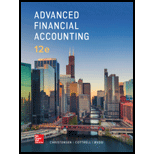
Concept explainers
Tax effects on unrealized intercompany profit:In a taxable transaction, the income tax effects of unrealized intercompany profit eliminations depend on whether the companies within the consolidated entity file a consolidated income tax return or separate tax returns.
When consolidated returns are filed, intercompany transfers are eliminated and only sales outside the consolidated entity both for tax and financial reporting purposes are recognized.
When each company within consolidated entities file separate returns, the profits are taxed individually on the profits of intercompany sales.
The elimination entries for intercompany sale of inventory and land for consolidation worksheet assuming P uses equity method in accounting for its investment in S services.
Want to see the full answer?
Check out a sample textbook solution
Chapter 10 Solutions
EBK ADVANCED FINANCIAL ACCOUNTING
- Provide answerarrow_forwardRivana Co. has a beginning receivables balance on March 1 of $1,280. Sales for March through June are $790, $860, $1,150, and $2,050, respectively. The accounts receivable period is 30 days. What is the amount of the May collections? Assume a year has 360 days.arrow_forwardSolve this Accounting problemarrow_forward

 AccountingAccountingISBN:9781337272094Author:WARREN, Carl S., Reeve, James M., Duchac, Jonathan E.Publisher:Cengage Learning,
AccountingAccountingISBN:9781337272094Author:WARREN, Carl S., Reeve, James M., Duchac, Jonathan E.Publisher:Cengage Learning, Accounting Information SystemsAccountingISBN:9781337619202Author:Hall, James A.Publisher:Cengage Learning,
Accounting Information SystemsAccountingISBN:9781337619202Author:Hall, James A.Publisher:Cengage Learning, Horngren's Cost Accounting: A Managerial Emphasis...AccountingISBN:9780134475585Author:Srikant M. Datar, Madhav V. RajanPublisher:PEARSON
Horngren's Cost Accounting: A Managerial Emphasis...AccountingISBN:9780134475585Author:Srikant M. Datar, Madhav V. RajanPublisher:PEARSON Intermediate AccountingAccountingISBN:9781259722660Author:J. David Spiceland, Mark W. Nelson, Wayne M ThomasPublisher:McGraw-Hill Education
Intermediate AccountingAccountingISBN:9781259722660Author:J. David Spiceland, Mark W. Nelson, Wayne M ThomasPublisher:McGraw-Hill Education Financial and Managerial AccountingAccountingISBN:9781259726705Author:John J Wild, Ken W. Shaw, Barbara Chiappetta Fundamental Accounting PrinciplesPublisher:McGraw-Hill Education
Financial and Managerial AccountingAccountingISBN:9781259726705Author:John J Wild, Ken W. Shaw, Barbara Chiappetta Fundamental Accounting PrinciplesPublisher:McGraw-Hill Education





